manual transmission FIAT 500L 2019 Owner handbook (in English)
[x] Cancel search | Manufacturer: FIAT, Model Year: 2019, Model line: 500L, Model: FIAT 500L 2019Pages: 248, PDF Size: 5.74 MB
Page 4 of 248

READ THIS CAREFULLY
REFUELLING
Petrol engines: only refuel with unleaded petrol with octane rating (RON) not less than 95 in compliance with the European specification
EN228. Do not use petrol containing methanol or ethanol E85. Using these mixtures may cause misfiring and driving issues, as well as
damage fundamental components of the supply system.
Diesel engines: refuel only with Diesel fuel motor vehicles conforming to the European specification EN590. The use of other products or
mixtures may damage the engine beyond repair and consequently invalidate the warranty, due to the damage caused.
For further details on the use of the correct fuel see the "Refuelling the vehicle" paragraph in the "Starting and driving" chapter.
STARTING THE ENGINE
Version with manual transmission (petrol engines): make sure that the handbrake is engaged; set the gear lever to neutral; fully depress
the clutch pedal without pressing the accelerator, then turn the ignition key to AVV and release it as soon as the engine has started.
Versions with manual transmission (Diesel engines): make sure that the handbrake is engaged; set the gear lever to neutral, fully
depress the clutch pedal without pressing the accelerator, then turn the ignition key to MAR and wait for the
warning light to switch off.
Turn the ignition key to AVV and release it as soon as the engine has started.
Versions with Dualogic transmission: make sure that the handbrake is engaged. Then depress the brake pedal, turn the ignition key to
AVV and release it as soon as the engine starts.
PARKING ON FLAMMABLE MATERIAL
The catalytic converter develops high temperatures during operation. Do not park the car on grass, dry leaves, pine needles or other
flammable material: fire hazard.
RESPECTING THE ENVIRONMENT
The vehicle is fitted with a system that carries out a continuous diagnosis of the emission-related components in order to help protect the
environment.
ELECTRICAL ACCESSORIES
If, after buying the vehicle, you decide to add electrical accessories (with the risk of gradually draining the battery), contact a Fiat Dealership.
They can calculate the overall electrical requirement and check that the vehicle's electric system can support the required load.
SCHEDULED SERVICING
Correct maintenance of the car is essential for ensuring that it maintains its performance and its safety features, its environmental friendliness
and low running costs for a long time to come.
Page 46 of 248
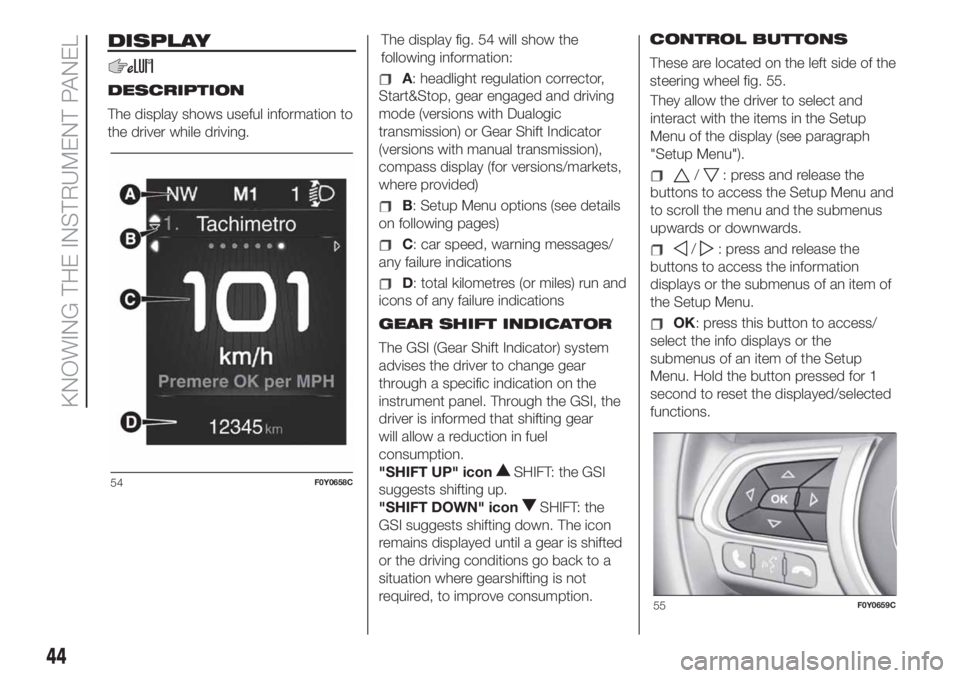
DISPLAY
DESCRIPTION
The display shows useful information to
the driver while driving.The display fig. 54 will show the
following information:A: headlight regulation corrector,
Start&Stop, gear engaged and driving
mode (versions with Dualogic
transmission) or Gear Shift Indicator
(versions with manual transmission),
compass display (for versions/markets,
where provided)
B: Setup Menu options (see details
on following pages)
C: car speed, warning messages/
any failure indications
D: total kilometres (or miles) run and
icons of any failure indications
GEAR SHIFT INDICATOR
The GSI (Gear Shift Indicator) system
advises the driver to change gear
through a specific indication on the
instrument panel. Through the GSI, the
driver is informed that shifting gear
will allow a reduction in fuel
consumption.
"SHIFT UP" icon
SHIFT: the GSI
suggests shifting up.
"SHIFT DOWN" icon
SHIFT: the
GSI suggests shifting down. The icon
remains displayed until a gear is shifted
or the driving conditions go back to a
situation where gearshifting is not
required, to improve consumption.CONTROL BUTTONS
These are located on the left side of the
steering wheel fig. 55.
They allow the driver to select and
interact with the items in the Setup
Menu of the display (see paragraph
"Setup Menu").
/: press and release the
buttons to access the Setup Menu and
to scroll the menu and the submenus
upwards or downwards.
/: press and release the
buttons to access the information
displays or the submenus of an item of
the Setup Menu.
OK: press this button to access/
select the info displays or the
submenus of an item of the Setup
Menu. Hold the button pressed for 1
second to reset the displayed/selected
functions.
54F0Y0658C
55F0Y0659C
44
KNOWING THE INSTRUMENT PANEL
Page 61 of 248
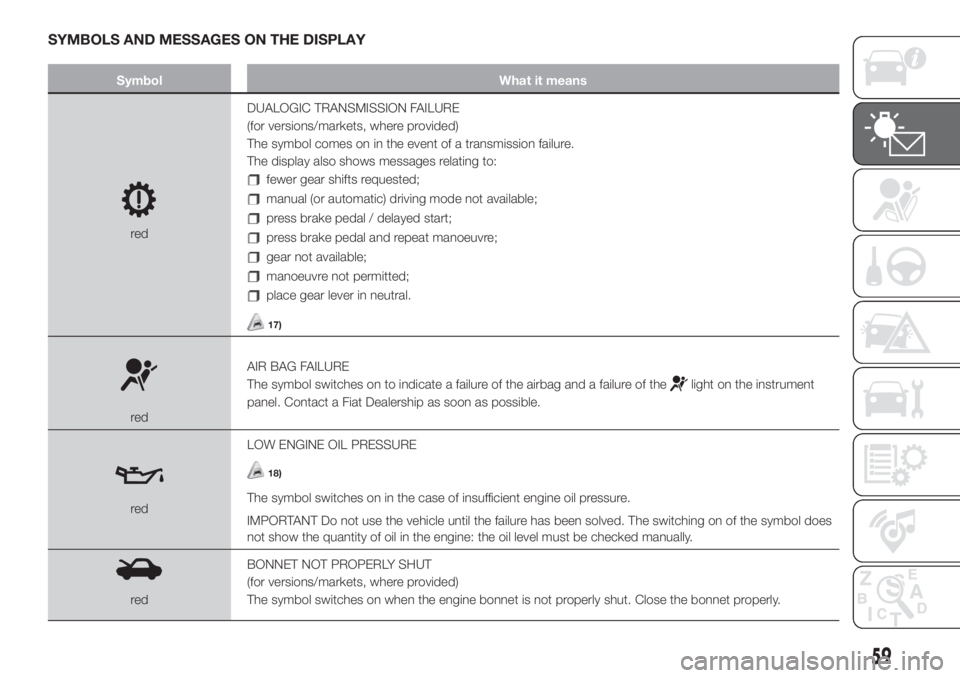
SYMBOLS AND MESSAGES ON THE DISPLAY
Symbol What it means
redDUALOGIC TRANSMISSION FAILURE
(for versions/markets, where provided)
The symbol comes on in the event of a transmission failure.
The display also shows messages relating to:
fewer gear shifts requested;
manual (or automatic) driving mode not available;
press brake pedal / delayed start;
press brake pedal and repeat manoeuvre;
gear not available;
manoeuvre not permitted;
place gear lever in neutral.
17)
redAIR BAG FAILURE
The symbol switches on to indicate a failure of the airbag and a failure of the
light on the instrument
panel. Contact a Fiat Dealership as soon as possible.
redLOW ENGINE OIL PRESSURE
18)
The symbol switches on in the case of insufficient engine oil pressure.
IMPORTANT Do not use the vehicle until the failure has been solved. The switching on of the symbol does
not show the quantity of oil in the engine: the oil level must be checked manually.
redBONNET NOT PROPERLY SHUT
(for versions/markets, where provided)
The symbol switches on when the engine bonnet is not properly shut. Close the bonnet properly.
59
Page 68 of 248
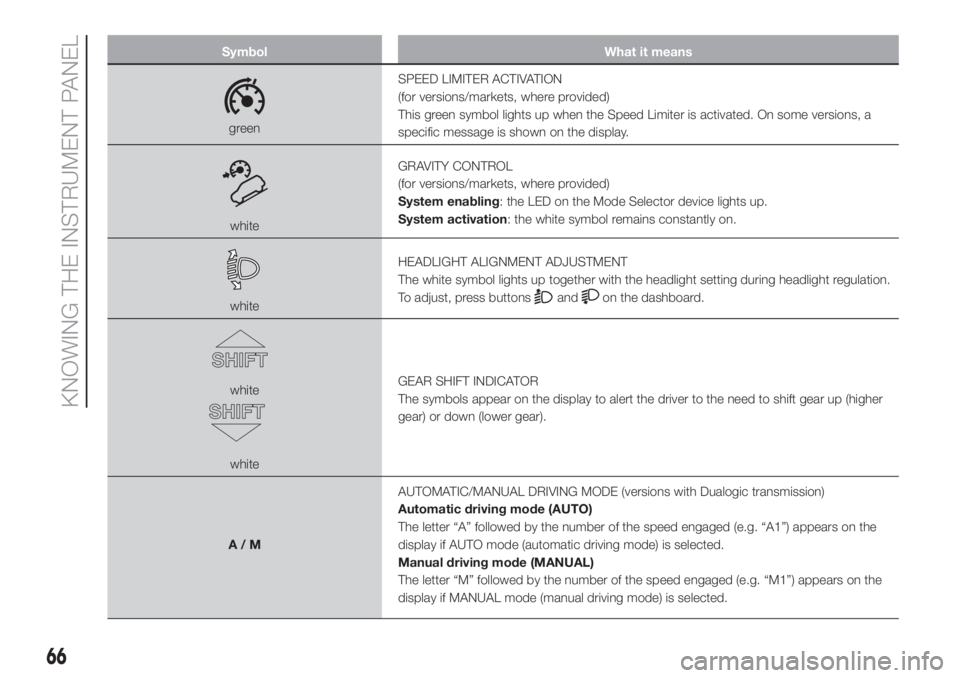
Symbol What it means
greenSPEED LIMITER ACTIVATION
(for versions/markets, where provided)
This green symbol lights up when the Speed Limiter is activated. On some versions, a
specific message is shown on the display.
whiteGRAVITY CONTROL
(for versions/markets, where provided)
System enabling: the LED on the Mode Selector device lights up.
System activation: the white symbol remains constantly on.
whiteHEADLIGHT ALIGNMENT ADJUSTMENT
The white symbol lights up together with the headlight setting during headlight regulation.
To adjust, press buttonsandon the dashboard.
white
whiteGEAR SHIFT INDICATOR
The symbols appear on the display to alert the driver to the need to shift gear up (higher
gear) or down (lower gear).
A/MAUTOMATIC/MANUAL DRIVING MODE (versions with Dualogic transmission)
Automatic driving mode (AUTO)
The letter “A” followed by the number of the speed engaged (e.g. “A1”) appears on the
display if AUTO mode (automatic driving mode) is selected.
Manual driving mode (MANUAL)
The letter “M” followed by the number of the speed engaged (e.g. “M1”) appears on the
display if MANUAL mode (manual driving mode) is selected.
66
KNOWING THE INSTRUMENT PANEL
Page 76 of 248

DRIVING
ASSISTANCE
SYSTEMS
The car can feature the following driving
assistance systems:
City Brake Control - “Collision
Mitigation” system
iTPMS
For the operation of the systems, see
the following pages.
CITY BRAKE CONTROL -
“Collision Mitigation”
SYSTEM
(for versions/markets, where provided)
57) 58) 59) 60) 61)
24) 25) 26) 27) 28) 29) 30) 31)
This is a driving assistance system,
which includes a laser sensor, located
in the upper part of the windscreen
fig. 57, that can detect the presence of
nearby cars in front of the car.
In the event of an imminent collision the
system intervenes by automatically
braking to prevent the impact or
mitigate its effects.
The system is only active if:
the ignition key is turned to
MAR;
the car speed is between 5 and
30 km/h;
a forward gear is engaged;
the front seat belts are fastened;
the “Mode Selector” device is
in “Normal” mode.
Engagement/disengagement
The system can be deactivated (and
reactivated) using the display setup
menu (see the "Display" paragraph in
the "Knowing the instrument panel"
chapter).
Operation
The system intervenes if there is risk of
imminent collision and the driver does
not press the brake pedal promptly.
If the system detects that the vehicle
ahead could be hit, it may prepare the
vehicle to a possible emergency
braking.If the driver does not carry out any
action to prevent the collision, the
system may automatically slow down
the vehicle, in order to prepare it to
a possible impact.
When there is risk of impact, if the
action on the brake pedal by the driver
is not sufficient, the system may
intervene in order to improve
the reaction of the braking system,
therefore reducing vehicle speed
further.
When driving uphill on slopes with
major changes of gradient, the system
may intervene, activating the braking
system.
Versions equipped with Start&Stop
system: at the end of the automatic
braking, the Start&Stop system will
activate as described in the "Start&Stop
system" paragraph of the "Starting
and driving" chapter.
Versions equipped with manual
transmission: at the end of the
automatic braking, the engine may stall
and turn off, unless the clutch pedal
is pressed.
For versions with Dualogic
transmission: the last gear stored
remains engaged after braking.
57F0Y0200C
74
SAFETY
Page 104 of 248

STARTING AND DRIVING
Let’s get to the core of the vehicle:
seeing how you can exploit all of its
potential to the full.
We’ll look at how to drive it safely in any
situation, so that it can be a welcome
companion, with our comfort and
our wallets in mind.STARTING THE ENGINE .................103
WHEN PARKED ..............................104
HANDBRAKE ..................................104
USING THE MANUAL
TRANSMISSION .............................105
USING THE DUALOGIC
GEARBOX.......................................106
START&STOP SYSTEM ..................108
CRUISE CONTROL (CONSTANT
SPEED REGULATOR) .....................109
SPEED LIMITER ..............................110
MODE SELECTOR ..........................111
PARKING SENSORS.......................114
REAR BACKUP CAMERA
(PARKVIEW® REAR BACKUP
CAMERA) ........................................116
TOWING TRAILERS ........................117
REFUELLING THE VEHICLE ...........118
ADBLUE® (UREA) ADDITIVE FOR
DIESEL EMISSIONS ........................121
102
STARTING AND DRIVING
Page 105 of 248
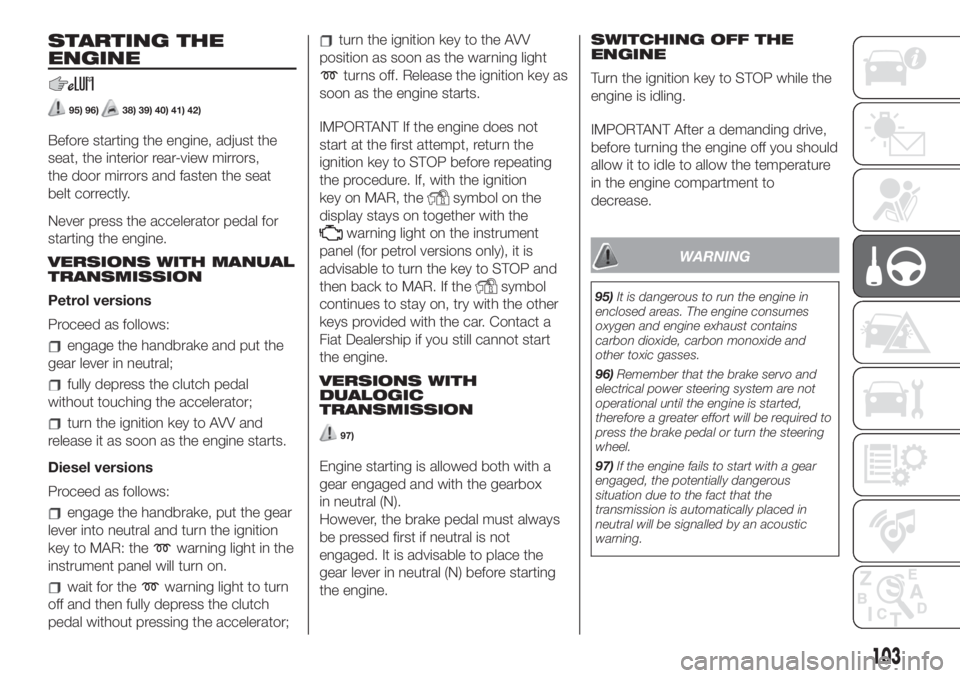
STARTING THE
ENGINE
95) 96)38) 39) 40) 41) 42)
Before starting the engine, adjust the
seat, the interior rear-view mirrors,
the door mirrors and fasten the seat
belt correctly.
Never press the accelerator pedal for
starting the engine.
VERSIONS WITH MANUAL
TRANSMISSION
Petrol versions
Proceed as follows:
engage the handbrake and put the
gear lever in neutral;
fully depress the clutch pedal
without touching the accelerator;
turn the ignition key to AVV and
release it as soon as the engine starts.
Diesel versions
Proceed as follows:
engage the handbrake, put the gear
lever into neutral and turn the ignition
key to MAR: the
warning light in the
instrument panel will turn on.
wait for thewarning light to turn
off and then fully depress the clutch
pedal without pressing the accelerator;
turn the ignition key to the AVV
position as soon as the warning light
turns off. Release the ignition key as
soon as the engine starts.
IMPORTANT If the engine does not
start at the first attempt, return the
ignition key to STOP before repeating
the procedure. If, with the ignition
key on MAR, the
symbol on the
display stays on together with the
warning light on the instrument
panel (for petrol versions only), it is
advisable to turn the key to STOP and
then back to MAR. If the
symbol
continues to stay on, try with the other
keys provided with the car. Contact a
Fiat Dealership if you still cannot start
the engine.
VERSIONS WITH
DUALOGIC
TRANSMISSION
97)
Engine starting is allowed both with a
gear engaged and with the gearbox
in neutral (N).
However, the brake pedal must always
be pressed first if neutral is not
engaged. It is advisable to place the
gear lever in neutral (N) before starting
the engine.SWITCHING OFF THE
ENGINE
Turn the ignition key to STOP while the
engine is idling.
IMPORTANT After a demanding drive,
before turning the engine off you should
allow it to idle to allow the temperature
in the engine compartment to
decrease.
WARNING
95)It is dangerous to run the engine in
enclosed areas. The engine consumes
oxygen and engine exhaust contains
carbon dioxide, carbon monoxide and
other toxic gasses.
96)Remember that the brake servo and
electrical power steering system are not
operational until the engine is started,
therefore a greater effort will be required to
press the brake pedal or turn the steering
wheel.
97)If the engine fails to start with a gear
engaged, the potentially dangerous
situation due to the fact that the
transmission is automatically placed in
neutral will be signalled by an acoustic
warning.
103
Page 107 of 248
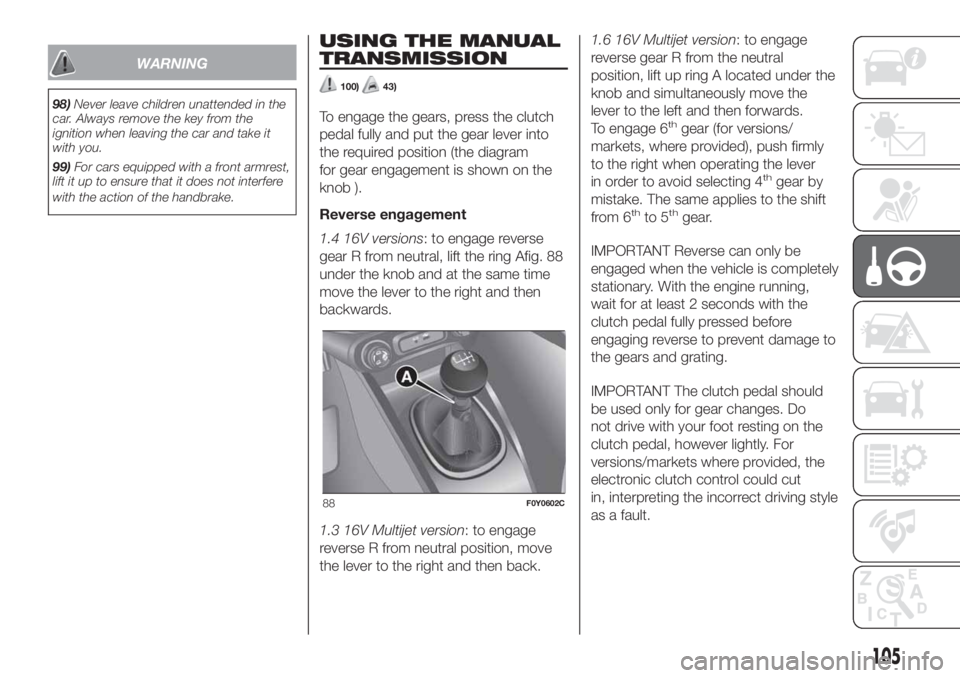
WARNING
98)Never leave children unattended in the
car. Always remove the key from the
ignition when leaving the car and take it
with you.
99)For cars equipped with a front armrest,
lift it up to ensure that it does not interfere
with the action of the handbrake.
USING THE MANUAL
TRANSMISSION
100)43)
To engage the gears, press the clutch
pedal fully and put the gear lever into
the required position (the diagram
for gear engagement is shown on the
knob ).
Reverse engagement
1.4 16V versions: to engage reverse
gear R from neutral, lift the ring Afig. 88
under the knob and at the same time
move the lever to the right and then
backwards.
1.3 16V Multijet version: to engage
reverse R from neutral position, move
the lever to the right and then back.1.6 16V Multijet version: to engage
reverse gear R from the neutral
position, lift up ring A located under the
knob and simultaneously move the
lever to the left and then forwards.
To engage 6thgear (for versions/
markets, where provided), push firmly
to the right when operating the lever
in order to avoid selecting 4
thgear by
mistake. The same applies to the shift
from 6
thto 5thgear.
IMPORTANT Reverse can only be
engaged when the vehicle is completely
stationary. With the engine running,
wait for at least 2 seconds with the
clutch pedal fully pressed before
engaging reverse to prevent damage to
the gears and grating.
IMPORTANT The clutch pedal should
be used only for gear changes. Do
not drive with your foot resting on the
clutch pedal, however lightly. For
versions/markets where provided, the
electronic clutch control could cut
in, interpreting the incorrect driving style
as a fault.
88F0Y0602C
105
Page 108 of 248
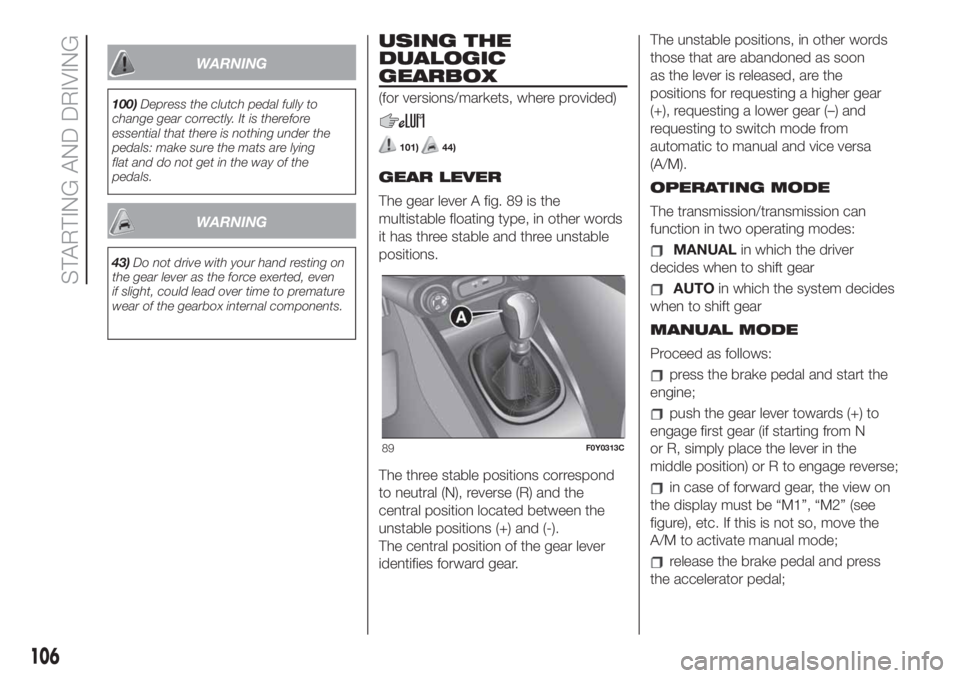
WARNING
100)Depress the clutch pedal fully to
change gear correctly. It is therefore
essential that there is nothing under the
pedals: make sure the mats are lying
flat and do not get in the way of the
pedals.
WARNING
43)Do not drive with your hand resting on
the gear lever as the force exerted, even
if slight, could lead over time to premature
wear of the gearbox internal components.
USING THE
DUALOGIC
GEARBOX
(for versions/markets, where provided)
101)44)
GEAR LEVER
The gear lever A fig. 89 is the
multistable floating type, in other words
it has three stable and three unstable
positions.
The three stable positions correspond
to neutral (N), reverse (R) and the
central position located between the
unstable positions (+) and (-).
The central position of the gear lever
identifies forward gear.The unstable positions, in other words
those that are abandoned as soon
as the lever is released, are the
positions for requesting a higher gear
(+), requesting a lower gear (–) and
requesting to switch mode from
automatic to manual and vice versa
(A/M).
OPERATING MODE
The transmission/transmission can
function in two operating modes:
MANUALin which the driver
decides when to shift gear
AUTOin which the system decides
when to shift gear
MANUAL MODE
Proceed as follows:
press the brake pedal and start the
engine;
push the gear lever towards (+) to
engage first gear (if starting from N
or R, simply place the lever in the
middle position) or R to engage reverse;
in case of forward gear, the view on
the display must be “M1”, “M2” (see
figure), etc. If this is not so, move the
A/M to activate manual mode;
release the brake pedal and press
the accelerator pedal;
89F0Y0313C
106
STARTING AND DRIVING
Page 110 of 248
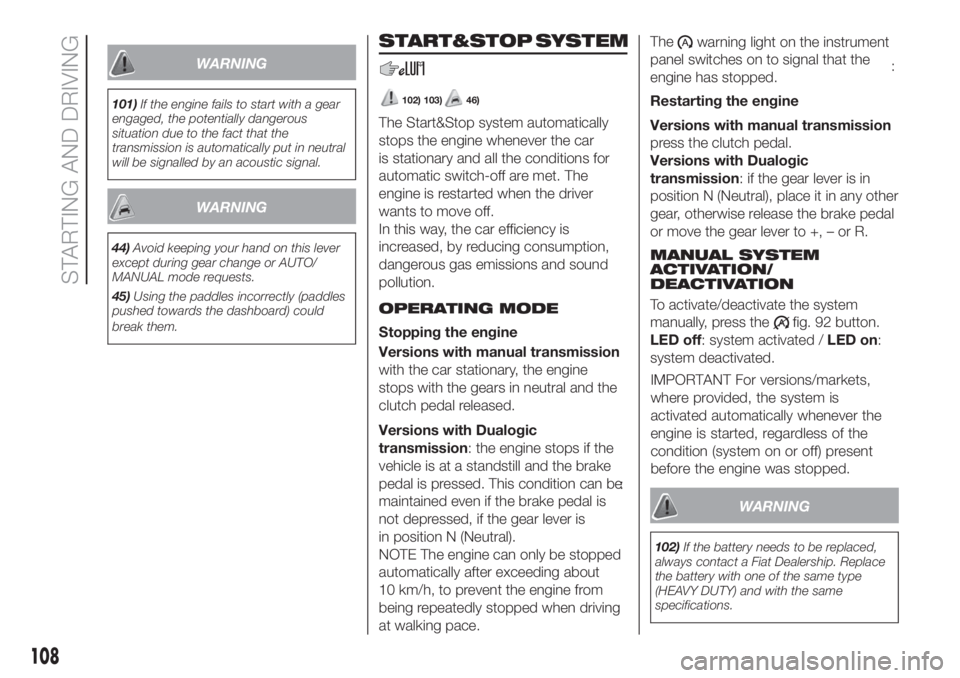
WARNING
101)If the engine fails to start with a gear
engaged, the potentially dangerous
situation due to the fact that the
transmission is automatically put in neutral
will be signalled by an acoustic signal.
WARNING
44)Avoid keeping your hand on this lever
except during gear change or AUTO/
MANUAL mode requests.
45)Using the paddles incorrectly (paddles
pushed towards the dashboard) could
break them.
START&STOP
SYSTEM
102) 103)46)
The Start&Stop system automatically
stops the engine whenever the car
is stationary and all the conditions for
automatic switch-off are met. The
engine is restarted when the driver
wants to move off.
In this way, the car efficiency is
increased, by reducing consumption,
dangerous gas emissions and sound
pollution.
OPERATING MODE
Stopping the engine
Versions with manual transmission
: with the car stationary, the engine
stops with the gears in neutral and the
clutch pedal released.
Versions with Dualogic
transmission: the engine stops if the
vehicle is at a standstill and the brake
pedal is pressed. This condition can be
maintained even if the brake pedal is
not depressed, if the gear lever is
in position N (Neutral).
NOTE The engine can only be stopped
automatically after exceeding about
10 km/h, to prevent the engine from
being repeatedly stopped when driving
at walking pace.The
warning light on the instrument
panel switches on to signal that the
engine has stopped.
Restarting the engine
Versions with manual transmission:
press the clutch pedal.
Versions with Dualogic
transmission: if the gear lever is in
position N (Neutral), place it in any other
gear, otherwise release the brake pedal
or move the gear lever to +, – or R.
MANUAL SYSTEM
ACTIVATION/
DEACTIVATION
To activate/deactivate the system
manually, press the
fig. 92 button.
LED off: system activated /LED on:
system deactivated.
WARNING
102)If the battery needs to be replaced,
always contact a Fiat Dealership. Replace
the battery with one of the same type
(HEAVY DUTY) and with the same
specifications.
108
STARTING AND DRIVING
IMPORTANT For versions/markets,
where provided, the system is
activated automatically whenever the
engine is started, regardless of the
condition (system on or off) present
before the engine was stopped.